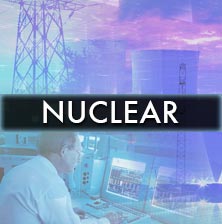The following is a small selection of items recently published by EPRI. To view complete lists of your company-funded research reports, updates, software, training announcements, and other program deliverables, log in at www.epri.com and go to Program Cockpits.

It has been hypothesized that grain boundary fission gas is responsible for fuel fragmentation observed in high-burnup fuel under simulated loss-of-coolant accidents. To increase understanding of fission gas’s role, this research used electron microprobe analysis and Monte Carlo simulation to evaluate intra-grain bubble gas content of high-burnup fuel.

This study compared current one-dimensional techniques for analyzing internal flooding in nuclear plants with a three-dimensional method. The flooding scenario, based on an actual nuclear plant, involved flooding in one room, spreading to a stairway and into another room. The research investigated the impact of different locations of the flooding source, combinations of 1-D and 3-D modeling for the different rooms, and the impact of a high flow rate under a door.

This report identifies bearing materials used in quarter-turn valves in nuclear power plants; summarizes information on bearing coefficient-of-friction (COF) associated with these materials; recommends bearing COFs for valve design calculations; and provides information to help determine whether additional tests are needed.

Developed by the nuclear power industry, the FLEX strategy involves placing emergency equipment in multiple plant locations—and also staging portable equipment in several off-site locations for transportation to the plant for mitigation and recovery operations. This report is a compilation of questions and answers generated by the utility FLEX Coordinators Group and the FLEX Preventive Maintenance Working Group

This study evaluated the availability and readiness of data and nuclear fuel cycle simulation tools to model the performance of liquid-fueled molten salt nuclear reactors.

In this study, researchers performed microstructural and micro-mechanical tests to evaluate embrittlement in seven high-fluence reactor vessel surveillance materials from several U.S. pressurized water reactors.

This mobile app helps fossil plant personnel to inspect for degradation in vertical-shaft, rotating-plate, regenerative air preheaters. It draws on operating experience of utilities and the EPRI Preventive Maintenance Basis Database.

This mobile app aids technicians with visual inspection of various condenser components and identification of common failures.

Effective management of distribution grids requires integration among distribution management systems, distributed energy resources, and microgrids. Researchers developed an architecture for an integrated system (including functions, communications, control, and interoperability) and identified gaps for integration.

Photovoltaic (PV) performance modeling plays an essential role throughout the life of a PV project, whether it be predicting output during design or assessing performance during operation. This report examines the biggest sources of modeling inaccuracy and explores potential solutions.

Information, communication, and cyber security technologies enable functions related to decisions and actions throughout the grid—from the transmission system to the distribution system to end-user devices. This document discusses objectives in this realm, the associated gaps, and research plans to bridge those gaps over the next 3-5 years.

This webcast discusses many aspects of the electric vehicle industry: sales, trends, new models, charging infrastructure efforts by utilities, emerging technologies, announcements from automotive companies, R&D (by EPRI and other institutions), and future industry development and their potential impacts on utilities and their customers.